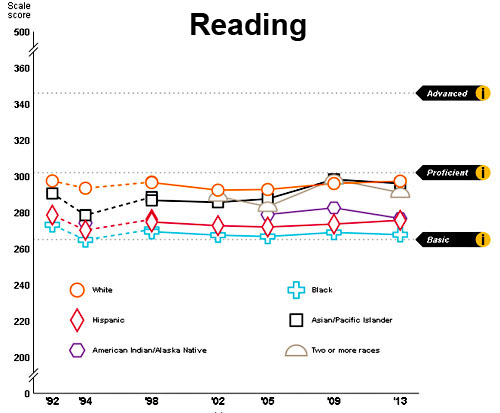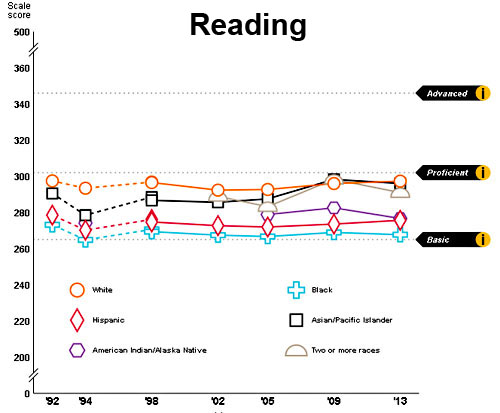
I periodically try to remind everyone that test scores for American students have not, in fact, plummeted over the past few decades. In fact, they’re up. To the extent that standardized tests can measure learning, American kids simply aren’t doing any worse than kids in the past. They’re doing better.
But there’s always been a caveat: this is only for grade school and middle school kids. All those test score gains wash out in high school, and today brings the latest evidence of this. Scores from the 2013 NAEP—widely considered the most reliable national measure of student achievement—are now available for 12th graders, and they confirm what we’ve known for a while. In reading, scores have been basically flat since 1992, and the scores for every racial subgroup have been pretty flat too. Math has only been tested since 2005, and scores have risen a few points since then. But not enough to demonstrate any kind of trend.
There are technical issues with testing 12th graders that can affect these scores. As dropout rates go down, for example, the test population becomes less proficient. And senioritis can affect how much effort kids put into these tests. Still, the best evidence indicates that we’re making pretty good progress improving the proficiency of students all the way through middle school, but we still haven’t cracked the code for high school. And in the end, that’s all that matters. It’s great that fourth graders are doing better, but if all those gains wash away in the final three years of high school, we’re not ending up any better than before.
UPDATE: Actually, math has been tested since 1990, but the test was revised in 2005 and scores before then aren’t comparable to current scores. A crude comparison suggests that scores actually have increased for 12th graders since 1990, perhaps by as much as ten points, though this is in direct contradiction to the long-term NAEP, which shows no gains at all for 17-year-olds. My own guess, based on both of these results, is that math scores have increased slightly since 1990, but probably not enough to really be noticeable.
















